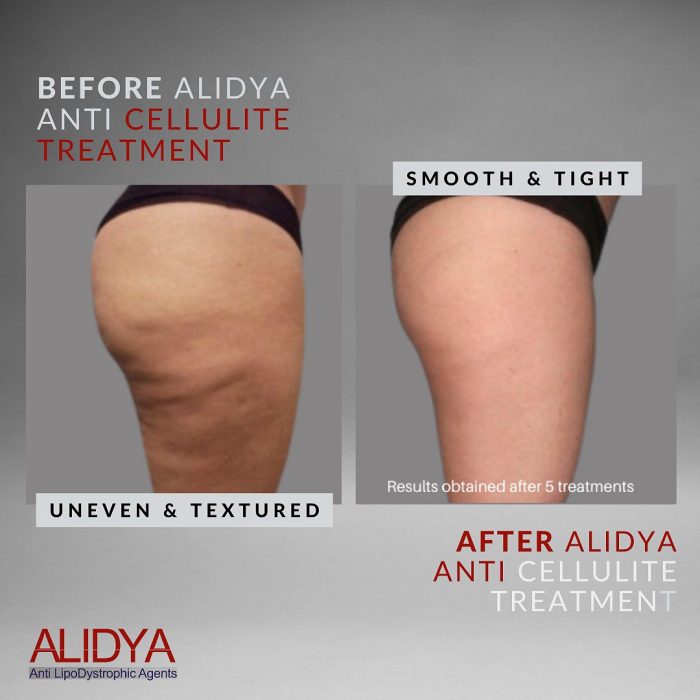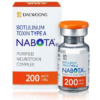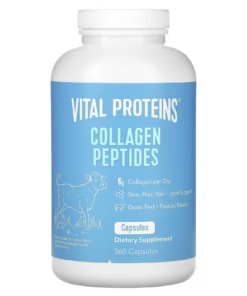Alidya: A Medical Overview of the Injectable Cellulite Treatment
Introduction
Cellulite, also known as gynoid lipodystrophy, remains one of the most challenging aesthetic concerns affecting women and, to a lesser extent, men. Despite extensive advances in cosmetic dermatology, cellulite continues to be a complex issue involving the interaction of skin, subcutaneous fat, connective tissue, microcirculation, and lymphatic function. Among the non-surgical treatment options, Alidya has emerged as a scientifically formulated injectable solution specifically designed to address the pathophysiology of cellulite.
Developed by Professor Pasquale Motolese, Alidya represents a milestone in aesthetic medicine as the first injectable medical device created explicitly for cellulite prevention and treatment. Its development was based on a deep understanding of biochemical imbalances, toxic accumulation in the extracellular matrix, and microcirculatory dysfunction that contribute to the appearance of dimpled, uneven skin texture.
This comprehensive overview presents a detailed analysis of Alidya, including its composition, mechanism of action, treatment protocol, efficacy, safety considerations, and practical insights from the clinical setting.


1. Understanding Cellulite: The Pathophysiological Foundation
Cellulite is not simply an accumulation of fat. It represents a multifactorial condition in which several processes occur simultaneously: alteration of connective tissue structure, microcirculatory impairment, lymphatic stasis, and localized inflammation.
Histologically, cellulite is characterized by fibrotic septa that tether the dermis to deeper tissues, while subcutaneous fat lobules protrude between these septa, producing the classic “orange peel” or “cottage cheese” appearance. Factors such as estrogen levels, genetic predisposition, lifestyle, poor lymphatic drainage, and local hypoxia contribute to its formation.
In essence, cellulite involves three interdependent mechanisms:
-
Microcirculatory insufficiency leading to hypoxia and poor nutrient exchange.
-
Retention of metabolic waste within the extracellular matrix, resulting in tissue acidification and inflammatory reactions.
-
Altered connective tissue architecture, promoting fibrotic bands and uneven surface contour.
Alidya was developed to address these underlying physiological imbalances rather than merely mask the visible symptoms.
2. Development and Scientific Background of Alidya
Alidya was formulated by Professor Pasquale Motolese after extensive research into mesotherapy, cellular biochemistry, and adipose tissue physiology. It is manufactured under sterile, CE-marked medical standards in Europe and is classified as a medical device rather than a pharmacological drug.
The solution was designed to restore physiological balance in areas affected by cellulite by detoxifying the tissue, improving oxygenation, and stimulating microcirculation. Unlike generic mesotherapy cocktails, Alidya’s components were selected based on their ability to correct the specific metabolic dysfunctions characteristic of cellulite tissue.
The product’s clinical development included controlled studies and widespread practitioner use in Europe, confirming both safety and efficacy when applied by trained professionals.
3. Composition and Biochemical Function of Alidya
Alidya’s formula is a sterile, injectable solution containing a blend of amino acids, trace elements, and regulatory compounds that act synergistically to restore cellular homeostasis. Although the exact proprietary formulation is not fully disclosed, its main components include:
-
Polyamino acid complexes: These contribute to improved tissue elasticity, hydration, and collagen synthesis, helping to normalize the extracellular matrix.
-
Amino acid buffer systems: Maintain physiological pH and support detoxification of acidic metabolites that accumulate in cellulite-affected regions.
-
Chelating agents (e.g., EDTA derivatives): Bind and neutralize toxic metals such as aluminum ions that may interfere with cellular respiration and enzymatic processes.
-
Osmolarity regulators and glucose substrates: Improve cell metabolism and energy availability, supporting local tissue repair.
-
Antioxidant components: Help counter oxidative stress, a contributing factor in connective tissue degeneration.
Together, these substances enhance microcirculation, reduce tissue acidosis, promote lymphatic drainage, and support the regeneration of collagen and elastin fibers.
4. Mechanism of Action
Alidya’s therapeutic mechanism is based on several interrelated actions within the dermal and subdermal layers:
4.1 Detoxification of the Extracellular Matrix
Cellulite-prone tissue often contains deposits of metabolic byproducts and ionic imbalances. The chelating agents in Alidya capture these waste substances, reducing local toxicity and restoring ionic equilibrium. This process improves tissue oxygenation and nutrient exchange.
4.2 Regulation of Microcirculation
By improving endothelial permeability and capillary tone, Alidya enhances local blood flow and promotes removal of excess interstitial fluids. Enhanced microcirculation leads to visible improvement in tissue color, firmness, and texture.
4.3 Lymphatic Drainage Stimulation
Lymphatic stagnation plays a key role in cellulite development. Alidya facilitates lymphatic flow, decreasing interstitial edema and fluid retention that contribute to the characteristic bumpy appearance of cellulite.
4.4 Collagen Remodeling
The amino acids and polyamino acids in Alidya act as substrates for collagen and elastin synthesis. Over time, the dermal structure becomes more organized, firm, and resilient.
4.5 Normalization of Adipocyte Function
Cellulite tissue exhibits abnormal fat cell hypertrophy and altered metabolic activity. Alidya promotes cellular respiration and energy metabolism, helping restore normal adipocyte behavior and reduce local inflammation.
Collectively, these mechanisms provide both visible and physiological improvements in skin smoothness and elasticity.
5. Indications for Use
Alidya is indicated for the prevention and treatment of cellulite in both early and established stages. It is primarily applied in areas with a high concentration of subcutaneous fat and visible skin irregularities, such as:
-
Thighs (anterior, posterior, and lateral regions)
-
Buttocks
-
Abdomen and flanks
-
Upper arms
-
Knees and hips
It may also be used prophylactically in patients prone to cellulite due to hormonal changes, lifestyle factors, or genetic predisposition. In addition, Alidya can support aesthetic improvement after liposuction or body-contouring procedures to enhance skin tone and prevent uneven texture.
6. Treatment Protocol
6.1 Preparation and Patient Selection
A comprehensive patient assessment is essential prior to treatment. This includes medical history, physical examination, and evaluation of cellulite grade according to standard classifications (e.g., Nürnberger–Müller scale). Candidates should have realistic expectations and understand that Alidya addresses cellulite rather than overall fat reduction.
Patients with bleeding disorders, uncontrolled diabetes, acute infections, or known hypersensitivity to any component of the solution should be excluded.
6.2 Administration Technique
Alidya is injected into the superficial subcutaneous layer using microinjections or mesotherapy techniques. The practitioner typically employs a fine-gauge needle (30G–32G) or mesotherapy gun. Injections are distributed evenly across the affected area, with a depth of approximately 4–10 millimeters, depending on the site and skin thickness.
6.3 Treatment Schedule
A standard treatment course consists of 7 to 12 sessions, spaced one week apart. The number of sessions depends on cellulite severity and patient response. Maintenance sessions may be scheduled every few months to sustain results.
Each session typically lasts between 30 and 45 minutes. Post-treatment, patients are advised to avoid intense physical activity, heat exposure, or alcohol for at least 24 hours. Gentle lymphatic massage may be recommended to enhance fluid drainage.
6.4 Combination Therapies
In advanced cases, Alidya may be combined with complementary treatments such as radiofrequency therapy, acoustic wave therapy, carboxytherapy, or manual lymphatic drainage to maximize outcomes.
7. Clinical Efficacy and Outcomes
Clinical observations and practitioner reports over the past decade indicate that Alidya achieves measurable improvement in cellulite appearance, particularly in mild-to-moderate cases.
7.1 Visible Results
Patients typically observe smoother skin texture, reduced dimpling, and improved tone after 4–6 sessions. The aesthetic effect continues to improve over subsequent weeks as collagen remodeling occurs.
7.2 Objective Evaluation
Ultrasound and thermographic analyses performed in clinical studies have demonstrated enhanced microcirculation, reduced interstitial edema, and more uniform subcutaneous tissue density following Alidya treatment.
7.3 Patient Satisfaction
Most patients report high satisfaction, particularly due to the non-surgical nature of the procedure, minimal downtime, and gradual yet natural-looking results.
8. Safety Profile and Side Effects
Alidya is generally well-tolerated when administered by trained professionals under aseptic conditions. Reported side effects are typically mild, transient, and self-limiting.
Common post-injection reactions include:
-
Mild erythema and swelling
-
Temporary bruising or tenderness
-
Slight itching or warmth in the treated area
Serious adverse effects are exceedingly rare. However, as with all injectable treatments, risks include infection, hematoma, allergic reaction, or nodular formation if improperly administered.
To minimize risk, practitioners should observe proper aseptic technique, use single-use materials, and follow manufacturer recommendations for dosage and injection depth.
9. Contraindications
Alidya should not be used in the following circumstances:
-
Pregnancy or breastfeeding
-
Known allergy to any of the product’s components
-
Active skin infection or inflammation at the injection site
-
Autoimmune diseases or systemic infections
-
Uncontrolled metabolic disorders such as diabetes mellitus
-
History of hypertrophic scarring or keloids
A pre-treatment consultation and possible patch test may be advisable for sensitive patients.
10. Post-Treatment Care and Maintenance
Following each session, patients are instructed to maintain adequate hydration, follow a balanced diet, and engage in regular physical activity to promote lymphatic flow.
Avoiding excessive salt intake, smoking, and prolonged sitting can enhance and prolong results. Practitioners often recommend maintenance treatments every 3 to 6 months, depending on lifestyle and cellulite recurrence tendency.
11. Comparison with Other Cellulite Treatments
Alidya is distinct from other mesotherapy-based or device-driven treatments in several respects:
-
Mechanism specificity: Unlike general mesotherapy cocktails, Alidya was formulated specifically to target cellulite’s biochemical root causes.
-
Safety profile: Its sterile, standardized composition minimizes risk of adverse reactions.
-
Non-surgical and minimal downtime: Compared to invasive procedures such as subcision or laser lipolysis, Alidya offers faster recovery.
-
Complementary potential: It can enhance the effects of other treatments when integrated into a multimodal aesthetic plan.
However, Alidya may produce slower results compared to energy-based therapies and requires patient compliance for a full course of sessions.
12. Practical Considerations for Practitioners
To ensure optimal outcomes, practitioners should:
-
Obtain informed consent and manage patient expectations.
-
Evaluate cellulite type (soft, hard, edematous) to tailor injection pattern and depth.
-
Use certified medical-grade materials only.
-
Document progress with standardized photographs and measurement tools.
-
Educate patients about long-term maintenance, lifestyle, and skincare routines.
Regular follow-up visits should assess progress and determine whether booster sessions are necessary.
13. Long-Term Benefits and Limitations
While Alidya effectively improves the appearance and texture of cellulite-affected skin, it does not permanently eliminate the underlying predisposition to cellulite. The treatment’s benefits are best maintained through ongoing care, proper diet, and physical activity.
The longevity of results typically ranges from 6 to 12 months after the final session, varying with lifestyle and hormonal factors. Maintenance therapy helps extend the aesthetic outcome.
14. Summary of Advantages
-
Scientifically designed formula targeting cellulite pathophysiology
-
Safe and non-surgical with minimal downtime
-
Suitable for all skin types and body areas
-
Progressive and natural-looking results
-
Enhances microcirculation and tissue detoxification
-
Can be integrated with other body-contouring procedures
15. Conclusion
Alidya represents an evidence-based, medically sound advancement in the management of cellulite. Unlike topical creams or mechanical procedures that merely address surface irregularities, Alidya acts at the biochemical and cellular levels to restore physiological balance in affected tissues.
Its unique mechanism—detoxification, microcirculatory improvement, and collagen regeneration—offers a multidimensional approach to one of the most persistent cosmetic concerns. For properly selected patients, and under the care of qualified practitioners, Alidya provides safe, consistent, and clinically meaningful improvement in skin texture and appearance.
As with all medical aesthetic treatments, individual results vary, and long-term success depends on patient compliance and lifestyle habits. Nonetheless, Alidya stands as a scientifically credible and clinically effective injectable therapy that bridges the gap between cosmetic desire and physiological restoration.
Be the first to review “ALIDYA” Cancel reply
Related products
Skin Care
Skin Care
Skin Care
Skin Care
Skin Care
Skin Care
Skin Care
Skin Care












Reviews
There are no reviews yet.